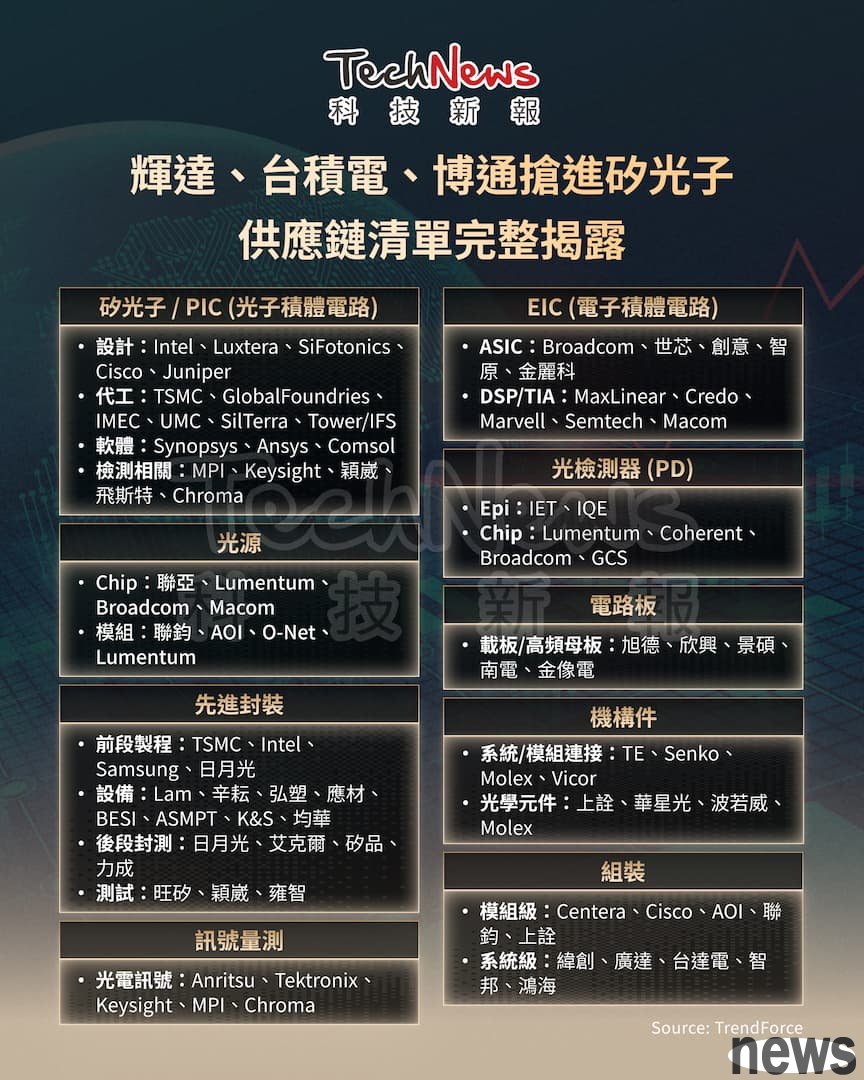NVIDIA's (NVIDIA) Spectrum-X, the first silicon photonic network switch built with co-packaged optics (CPO) technology, has been adopted by two giants such as Oracle and Meta, announcing that "the age of optical communications in the AI w...

NVIDIA's (NVIDIA) Spectrum-X, the first silicon photonic network switch built with co-packaged optics (CPO) technology, has been adopted by two giants such as Oracle and Meta, announcing that "the age of optical communications in the AI world is coming." The optical communications industry described that the fire ignited by AI is driving the industry into a golden growth period that will last at least three years.
NVIDIA CEO Jensen Huang said that with the advent of the mega-parameter level model era, data centers are being transformed into "super AI factories", and Spectrum-X will become the "nervous system" connecting millions of graphics processing units (GPUs). In other words, silicon photonic network switches will break the limitations of existing networks and achieve large-scale integration of electronic circuits and optical communications.
Among them, upgrading the internal network of the data center, especially the optical fiber interconnection in the Spine-Leaf switching architecture, has become a top priority for cloud service providers (CSP). The traditional Pluggable Transceiver will re-rectify the electrical signals through DSP. Although this approach ensures the accuracy of data transmission, it also brings considerable power consumption. Therefore, the industry is now beginning to adopt LPO technology.
Before CPO increases its volume, market demand will be fulfilled by pluggable optical transceiver modules.The industry generally expects that CPO technology will have the opportunity to enter mass production in the highest-end AI market at least after the second half of 2026, and will enter a gradual increase in volume after 2027. Before then, during the window period of more than 2 years, the huge market demand will be taken over by pluggable optical transceiver modules (Pluggable &&;LPO).
According to legal person analysis, from the huge investment of terminal cloud service providers (CSP), to the active expansion of upstream material factories, to the optimistic outlook and record performance of midstream component leaders, the demand visibility of the entire optical communication industry chain is extremely high, including indium phosphide (InP) substrates, laser diodes (LD), photodetectors (PD), and optical transceiver modules. The entire supply chain is in short supply.
Observing that major suppliers have announced large-scale production expansion plans to cope with strong orders, the revenue data and financial forecasts of Lumentum, Coherent and other index manufacturers have confirmed the substantial contribution of AI orders. It is worth noting that the heart of the optical transceiver module is the laser light source. Its performance and output directly determine the quality and speed of data transmission. The demand for AI has brought an unprecedented wave of orders to the world's major laser suppliers.
Lumentum clearly stated in its fourth quarter 2025 press conference that it is currently at the "frontline of the cloud and AI revolution" and that AI strategies have become the core of its customers' businesses, driving "sharp growth" in demand for optical hardware and bandwidth. Coherent also feels strong market demand, with the single-quarter revenue of its 800G transceiver business exceeding the US$100 million mark.
Legal person inventory list of stable suppliersSince the technical core of optical modules with speeds of 800G and above lies in high-speed, high-reliability electroabsorption modulation laser (EML), the technical threshold of single-channel 200G EML chips is extremely high. Currently, only a few manufacturers in the world, such as Lumentum, Coherent, Broadcom, and Sumitomo, can provide stable supply, and the epitaxy quality of PD is also the "foundation" of signal integrity.
The representative of PD epitaxy suppliers is IET-KY. As AI servers have driven a surge in demand for PD chips, IET's InP epitaxy products have accounted for more than 50%, and the expansion will be completed in 2026. IET-KY meets customer demand by producing larger-sized PD epitaxy, and the supply and demand situation directly affects the development of the entire industry.
The legal person emphasized that the demand for data bandwidth driven by the AI revolution is bringing a historic structural growth opportunity to the global optical communications industry. Both supply and demand ends of the entire industry chain are showing extremely strong growth trends. The growth path of the overall optical communications industry is clearly visible. Market demand is strong and the supply chain is actively expanding. It is estimated that at least in the next three years, there will be no dark clouds in the optical communications industry.
